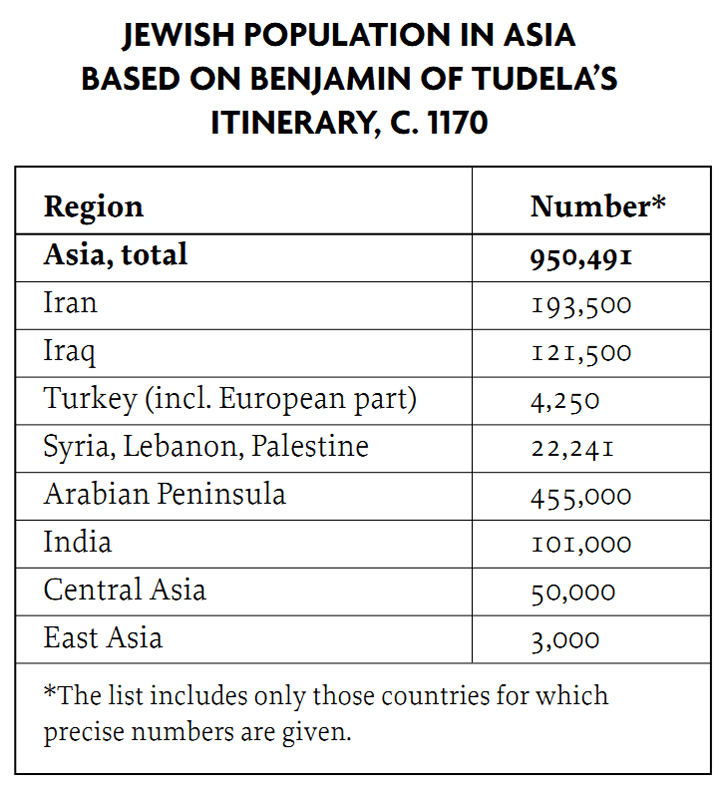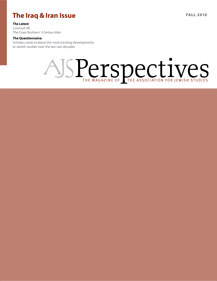 Both Iraq and Iran hosted ancient and large Jewish populations. The large communities in the broad area encompassing both countries offered paramount contributions to the development of global Jewish civilization in various and different ways and for a while served as the Jewish spiritual and cultural capital center. Some of these influences spanning more than 2,500 years still remain among the pillars of contemporary Jewish religious, social, and historical identity. To some extent, the Jewish presence long preceded the definitive cultural consolidation of the host societies.
Both Iraq and Iran hosted ancient and large Jewish populations. The large communities in the broad area encompassing both countries offered paramount contributions to the development of global Jewish civilization in various and different ways and for a while served as the Jewish spiritual and cultural capital center. Some of these influences spanning more than 2,500 years still remain among the pillars of contemporary Jewish religious, social, and historical identity. To some extent, the Jewish presence long preceded the definitive cultural consolidation of the host societies.
Starting from the end of the first millennium of the Christian era, however, the regional cultural hegemony within world Jewry was shifting westward. It shifted repeatedly again during the second millennium, leaving Iran and Iraq—together with many other communities—in a semiperipheral position vis-à-vis the new emerging centers of global Jewish peoplehood. The long tale of Jews in Iraq and Iran reached a stage of sudden decline during the second half of the twentieth century. Harsh societal circumstances, large-scale acceptance of the Zionist project and migration to Israel, and other opportunities offered elsewhere by the global political and economic system virtually ended a great civilizational cycle.
The more ancient presence of Jews in Iraq and Iran lies beyond the scope of this review, which focuses instead on the contemporary period. In general, information on population characteristics and trends is more easily available for Iraq than for Iran, and in several ways the former has often been considered the more culturally accomplished and influential. However, it is interesting to go back to Benjamin of Tudela's itinerary and memorial toward the end of the twelfth century to find that his estimates indicate a much larger Jewish population in Iran than in Iraq. Taking at face value his quite detailed reporting—which of course would require more critical analysis than allowed here— Iran then hosted 193,500 Jews, compared to 121,500 in Iraq. The latter number seems more grounded on direct observation or at least on secondhand sources available to our traveler. And it is worth recalling that Benjamin's accounts tend to be reliable when crosschecked with solid, modern historiography.
Whatever the intrinsic value of these early statistical estimates, the important notion is that both Iran and Iraq were perceived to be among the most important and influential regional concentrations of Jews at that time, other than the much higher numbers—more or less credible—provided for the Arabian Peninsula. The latter would be, in Benjamin's account, the largest single regional concentration of Jews then existing in the world. Jews in Iran and in Iraq were spread both across several major and a large number of minor local communities. The area that can be roughly identified as contemporary Iran had a significantly larger Jewish population than that of Iraq. However, by the middle of the twentieth century, although the number of Jews in Iraq would be extremely close to Benjamin's estimates for the end of the twelfth, the numbers in Iran would be significantly lower—hinting perhaps at harsher circumstances for local Jews.
During the period between the Middle Ages and the nineteenth century, the population of most areas in the Middle East did not grow much because of the generally poor economic, social, and health conditions. Among Jews, slow population growth was likely interspersed with significant declines in the ability or willingness to maintain a cultural and religious identity separate from that of the Muslim majority. It can be estimated that the number of Jews for the whole of Asia shrank from about one million to less than a quarter of a million at the beginning of the eighteenth century. Modest recoveries during the following two hundred years would put the overall continental estimate at 300,000 Jews in 1800 and 535,000 in 1900 (of which 50,000 would have been in Palestine and 100,000 in the Central Asian areas of the former Soviet Union). It is only in the twentieth century that the Jewish population would start to grow more rapidly, although somewhat impaired by incipient emigration.
In 1947/48, at the time of Israel's independence, reasonable Jewish population estimates would be 135,000 for Iraq and 90,000 for Iran. Subsequent years would witness rapid emigration, though at a very different pace for the two Jewish communities and consequently with different effects on the continuation of Jewish life in the two countries. The model for Iraq was the nearly total transfer to Israel within a short span of time—mainly through "Operation Flying Carpet." Between 1948 and 1953, 125,000 Iraqi Jews migrated to Israel, and forty-seven years later, by 2010, total migration had augmented by only a few thousand to 129,000. In the case of Iran, migration was much more gradual and also less exclusively focused on Israel in the longer term. Out of a grand total of more than 82,000 Jews who left Iran for Israel between 1948 and 2010, 27,000 moved in 1948–53, followed by successive waves peaking at 12,000 during the early 1960s, over 9,000 during the years of the Khomeini Islamic revolution, and over 5,000 during the late 1980s.
In 2008 there were 64,100 Jews born in Iraq and 47,100 born in Iran living in Israel; plus, respectively, 169,400 and 87,600 born in Israel whose father was born in one of the same countries. The overall estimates of 233,500 Iraqis and 134,700 Iranians ignore the third and further generations of the descendents of these immigrants, as well as those born in Israel, whose mother but not whose father was born in the given country. The actual sizes of the respective enlarged communities are therefore significantly larger.
In the United States, according to the 2000–01 National Jewish Population Survey (NJPS), about 5,000 Jewish adults were born in Iraq and about 20,000 were born in Iran. Here, too, these figures omit second- and third-generation descendents. Following these extensive migrations and the resettlement of emigrants in Canada, Western European countries, and elsewhere, few Jews remained in either Iraq or Iran. Regarding Iraq, with the departure of the last few Jews following the American campaign there, virtually nobody was left in the community. In Iran the slower pace of emigration, in spite of highly visible anti-Jewish and anti-Israeli rhetoric and periodical political harassment, reflected partly the inherent logistical difficulties, partly the persistence of a moderately affluent middle class among the Jewish community. The Jewish population was realistically estimated at 10,000–12,000 in 2010, although significantly higher estimates also circulated in an attempt to transmit a positive image of "business as usual."
The integration of Iraqi and Iranian Jews in Israel, where most of both original Jewish populations eventually landed, followed the patterns and predicaments of mass aliyah. During the first years after arrival, the Israeli melting pot (or, perhaps more appropriately, salad bowl) developed through rapid demographic adaptation and convergence but also through significant sacrifices in socioeconomic status among all participants in mass immigration. It is well documented that Jews from Asia and Africa paid a heavier price in this process than Jews from Europe and America. Different origin groups also did not bring the same initial characteristics and tools, and their subsequent mobility processes also reflected these initial differentials among immigrants along with the opportunities that were being created in the new society. From this angle, at their arrival in Israel, Jews from Iraq were in many respects significantly more modernized than Jews from Iran. Life expectancy before migration to Israel was retrospectively estimated at 50–54 years in Iraq and 46–51 in Iran. Among those who married before 1960, age at marriage was one to two years older among brides and three to four years older among grooms in Iraq. Among women married abroad and surveyed in Israeli censuses, completed family size (at age 45–49) was 6.3 children for the Iraqis versus 7.3 for the Iranians in 1961; 5.5 versus 6.2, respectively, in 1972; and 5.1 children for both in 1983.
Similar patterns emerge from a comparison of socioeconomic characteristics of the immigrants a few years after they had settled in Israel. In 1961, 28 percent of men and 65 percent of women above 30 years of age born in Iraq had not attained any schooling, versus 34 percent of men and 73 percent of women born in Iran. At the opposite end of the educational ladder, 8 percent of men and 1 percent of women over 30 born in Iraq had thirteen or more years of education, versus of 2 percent men and 0.1 percent of women born in Iran. Regarding the occupational structure abroad, immigrants who arrived in Israel from Iraq in 1948–53 included 22 percent in managerial and clerical professions, 30 percent in trade and sales, 3 percent in agriculture, and 45 percent in other blue-collar occupations. Among immigrants from Iran, 8 percent were in managerial and clerical professions, 31 percent in trade and sales, 13 percent in agriculture, and 53 percent in other blue-collar occupations. These differentials help explain the more rapid and visible entrance of Iraqis (as compared to the Iranians) into Israel's system of economic, professional, military, and political elites.
An analysis of the 1995 Israeli census indicated some degree of regional proximity in the geographic spread of Jews from Iraq and Iran, reflecting the prevalent role of immigration during the first decade of Israeli statehood versus other much more veteran or much newer immigrant groups. However, the typological location of Iraqis was quite contiguous with Jews from Poland and Germany, their three denser locations being Ramat-Gan, the Kinneret natural region, and Petach Tikva, while Iranians were closer to Jews from Turkey, Greece, and Bulgaria, their three denser locations being Holon, Jerusalem, and Petach Tikva. Indeed by 1995, after many years of hardship, Iraqi and Iranian Jews had finally joined the mainstream of Israeli society.

